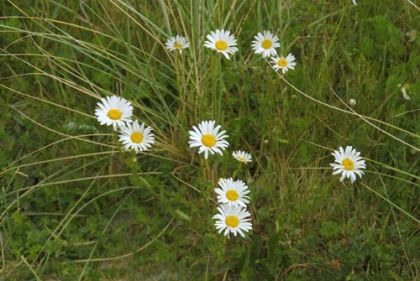Also known as Dog daisy and Chrysanthemum Leucanthemum, this familiar flower brightens our grass verges, meadows and many motorway embankments from May to September. The flowers (25-50mm ) are borne on strong, erect, ridged stems (to 80cm high) and have white spreading rays (like petals) and a prominent yellow centre of disc florets. The dark green leaves are spoon-shaped, stalked and form a rosette, the stem leaves are alternate, lanceolate and sessile. The name Daisy comes from the Old English 'dæges ēage' or day's eye, as the flower opened up as the sun came up. This is a native plant and belongs to the family Asteraceae.
I first identified this plant in 1978 in Killiney, Co Dublin and photographed it in Ballymitty, Co Wexford
If you are satisfied you have correctly identified this plant, please submit your sighting to the National Biodiversity Data Centre




